Eye tracking and video games research
- November 4, 2021
- Dawid Zalewski
User experience research is nothing new in the video games industry. Whether it’s small indie developers or industry leaders such as Sony, Activision Blizzard and Electronic Arts, game production companies are fully aware that professional research and UX tests significantly reduce the risk of market failure or financial loss. Players’ opinions are important and should be taken into account during development process. However, it must be remembered that even the most honest players are not fully aware of all their emotions and behaviors. In order to track unconscious processes and unearth precious information, modern UX research uses biometric data: electroencephalography, galvanic skin response, or eye tracking. In this article, I will discuss the use of the eye tracking methodology in video games research.
What is eye tracking?
Eye tracking is a technology that allows us to track the eyesight and eyes activity – movement of eyes, eyelids and pupils. Eye tracking methodology is based on Pupil Center Corneal Reflection (PCCR). The eye tracking device emits infrared waves which reflect from the cornea of the respondent’s eye and are sent back to the sensor. Based on the place where the waves reflect on the eye and how far that place is from the center of the pupil, an algorithm calculates where exactly on the screen player was looking. As a result, the researcher can see where and for how long the player looked, and how the player’s eyes were moving on the screen during the game.
How can eye tracking be used in video games research?
Eye tracking research provides us with valuable and not always obvious information, often impossible to gather in any other way, also in games research. What was the player looking at? How long did they look at it? When did they blink? Was their pupil dilating or constricting when a specific stimulus appeared?
This information is extremely useful while designing interfaces, HUDs, tutorials, during website usability tests (including online stores such as Steam or Epic Games) or for testing trailers.
Additionally, data such as blinking frequency, pupil size, distance from the screen or the number of fixations (i.e. the times in which the eyes focus on one spot) can inform us about player’s involvement, emotional arousal, boredom, or cognitive overload they experience. The researchers also proved that
the number of fixations can be an indicator of the level of immersion experienced by the player. The less frequently players change fixation points, the more immersed they are.
User interface and HUD – Assassin’s Creed Unity and Gord
User interface and HUD are the most direct and basic ways for the game to communicate with players. Health bars, mana and stamina, minimaps helping with navigation, or all kinds of quest logs allow the players to comfortably and efficiently interact with the game. A poorly designed interface can cause the players some serious frustration, and (if the game itself is not intriguing) make them put the game back on the shelf.
With eye tracking data, designers can create better, more intuitive, and easy to use interfaces, just like it was during creations of Assassin’s Creed Unity.
As Pierre Chalfoun and Jonathan Dankoff describe in the book Games User Research, in the production process, the developers wondered why their players struggle with the effective use of provided mechanics to perform stealth actions. To explore this problem, an eye tracking study was carried out. It showed that one of the key stealth indicators (showing if the player is visible to the enemies or not) is misplaced. Initially, that indicator was placed in the upper left corner of the screen, but – as can be seen in the heatmap below – none of the tested players looked at this place even once during the game.
To improve the experience of stealth gameplay for the players and make them aware of the indicator, developers decided to move it closer to the minimap. As the eye tracking analysis showed, the minimap – center corridor contained nearly 50% of players’ attention.
The change, although subtle, made the HUD more usable, and positively affected players’ stealth performance in the next iterations.
User interface analysis (as shown in the Assassin’s Creed Unity example above) is one of the standard biometric research services provided by Try Evidence (Gamer Experience Tracking Biometrics). One of the many projects where we performed such analysis is the game Gord from the Polish studio Covenant.dev.
The following graphics presenting Areas of Interests (AOI) shows, that the vast majority of HUD elements were generally noticed by the players, with the exception of the resource indicator, which was noticed by only three out of nine tested players (top panel – resources; ratio). Depending on the research conditions, production stage or level played, there can be many reasons for this. For example, it could be due to low visibility of the icons, poor tutorial, or, as in the case of Gord, playing an early part of the game. During early game, the information about the resources held was not necessary for the participants to play the game and build structures – at this stage they still had ample resources to use.
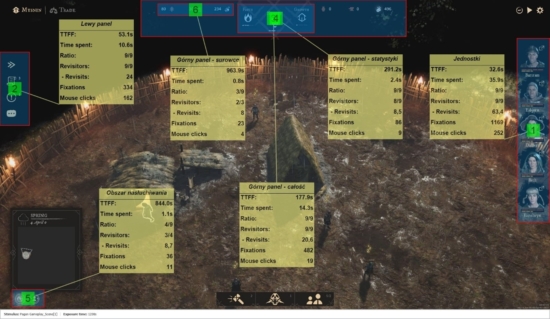
TTFF – Time to first fixation
Interested in eyetracking tests for the game you publish or develop?
Contact usTutorial – Broken Ranks
The tutorial is usually the first thing the player encounters when starting a new game. It is therefore important to make sure that it is designed well and makes a positive impression. We wrote more extensively about designing tutorials in the article How to design a perfect game tutorial? In the article, we discuss the eight tips for creating an informative tutorial that serves its purpose well.
Design tips notwithstanding, it is always worth to test if the tutorial is understandable and properly introduces the game world to the players. It might turn out that a certain gameplay mechanic or system seemed so simple and accessible that the developers didn’t bother to explain it properly, or did so only partially. A detailed explanation might actually be needed to make the game understood by players.
Good understanding of the game mechanics and systems affects players’ further experience, hence the need to make sure that the players do not encounter any difficulties at this stage. According to our research experience, it’s especially worth to check these three points:
- Does the player see all the necessary cues, markers and explanations? A player who missed a piece of information will be frustrated with the game and upset that they can’t achieve their goals. These emotions are also aggravated by the difficulty identifying the cause of the problem. Our experience shows that as long as the players know why they’re struggling but have some ideas on how to solve their problems, they treat such a situation as a challenge. In other words, the frustration is lower when they are able to pinpoint the cause of their failures.
- Can the player keep up with the pace of presenting information (or aren’t they bored by too slow pace)? This point is particularly important for tutorials where the player can’t freely skip tips at their own pace.
- Does the player understand presented information? (including both text, and all kinds of indicators, arrows or highlights).
We have tested the above aspects in Broken Ranks, a MMORPG game created by the Wroclaw based developer Whitemoon Games.
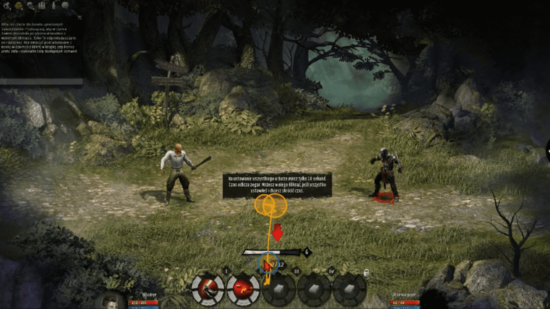
Thanks to eye tracking we also learned that the used language is unlikely to be a problem for the players (they needed to read cues only once to understand them),
what they confirmed later on during the interviews.
Eye tracking is a very important part of games tutorial research. While it may seem like an easier and more effective way to simply ask players what do they think about the tutorial,
we should remember that even though players’ statements and declarations are extremely valuable and should be taken into account, players are not always aware of what exactly causes their difficulties in the game.
And even if they are, they may not want to share this information. For example, a player who did not understand the tutorial or had some problems reading the cues may be embarrassed to admit their difficulties and tell the researcher about them (because it could, for example, affect player’s self-esteem). The eye tracker, on the other hand, will clearly show that the participant read the tip several times, what points to a difficulty understanding the text. Combined with the observation of the player’s behavior later in the game, it gives a clear picture of the problem to be solved.
Websites – The Medium
People spend between 10 to 20 seconds on a website. You need to make sure that the user sees and remembers the key information.
Most often, people do not read the page, but only quickly scan the content. The way they do it depends, among other things, on how a given page is designed – colors, bulletpoint placement, layout, and so on.
The above aspects (design and information structure) favor the emergence of characteristic patterns according to which people scan websites. These patterns, in turn, affect which elements – and to what extent – will be remembered by users.
The fixation sequences obtained in the eye tracking research allow us not only to indicate whether all the necessary information was noticed by the user, but also to determine which parts of the website draw the most attention, how involved the user were and in what order did they analyze all of the website elements.
When designing or redesigning website it is always worth to look into eye tracking data. If the respondents skip any of the important elements, it is good to thing about exposing it better – or moving it somewhere else.
An example of the use of eye tracking in website usability tests was an audit of the website for The Medium we performed for Bloober Team. As the research showed, the tested site was not only seen as very aesthetic and substantive, but also highly usable. All of the most important elements were noticed by the participants, and despite the specific use of scroll to show one of the main game mechanics – two worlds – the site did not cause any problems for the players.
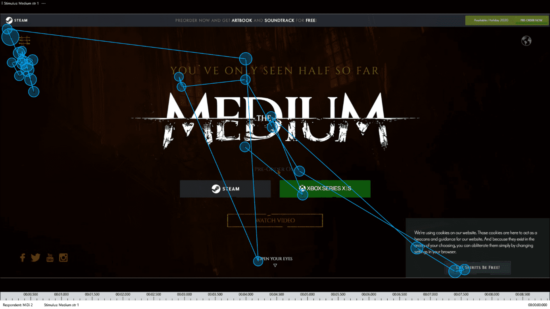
What else can we use eye tracking for in games research?
Apart from the research in which it’s a key method of obtaining data,
eye tracking perfectly complements classic playtests. Thanks to the live preview of fixation sequences, the researcher is able to “get inside playtester’s head” and understand their intentions or encountered problem
better than using classic observation methods alone. It is also a valuable insight for an interview later on – seeing the player’s unusual behavior (e.g. searching the interface chaotically or reading the content several times) a researcher can ask participant about the difficulties they experienced. As I mentioned earlier, eye tracking also informs us about player’s involvement, emotional arousal or allows us to draw some conclusions about immersion level experienced by the player.
Additionally, eye tracking perfectly complements other biometric methods, such as galvanic skin response (GSR), which, based on the changing electrical resistance of the skin, informs about the physiological stimulation experienced by the player. The information about arousal peaks combined with fixation points can show which scenes and assets are more stimulating for the players, and which are less. This method is extremely useful for testing game trailers or cutscenes. Example of this can be seen in the following materials from our research on the attractiveness of gaming heroes and heroines or dynamic heatmap from Hellblade II trailer analysis. Using biometric data, developers and publishers can create more engaging and arousing content which will be remembered and rated better.
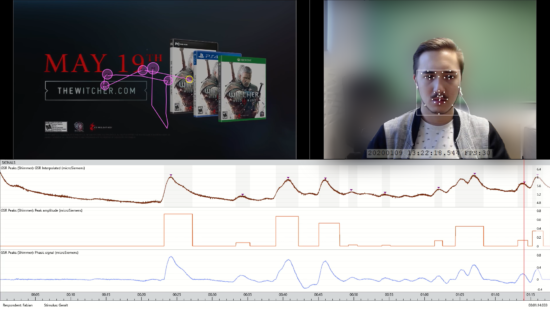
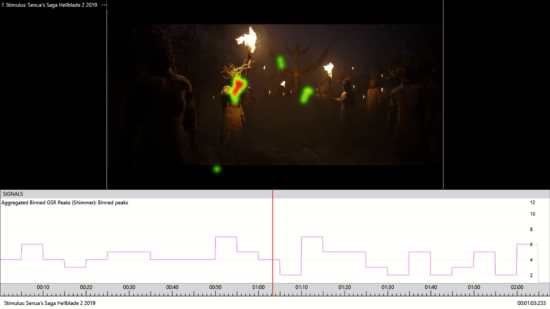
Summary: is eye tracking useful in games user research?
Although in many cases it is not necessary, eye tracking (as well as other biometric research) is a method definitely worth considering if you’re thinking about testing games you are creating or publishing.
Data collected from eye tracking provide a lot of valuable and, importantly, objective information. Most of all, they help us to understand player’s problems that even they do not understand and are not aware of. They also make the player’s goals and intentions clearer and help understand why they play the way they play. It’s the undoubted advantage of research with eyetracking – the possibility to go deeper and understand the player’s behaviors more thoroughly than just by observing what’s visible to the “naked eye”. Interviews and surveys, though invaluable, only provide us with declarations and subjective feelings of the surveyed players, and these may sometimes turn out to be insufficient. Especially in the cases I discussed above.






